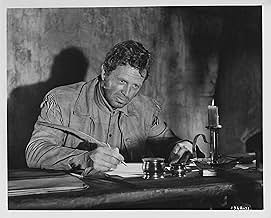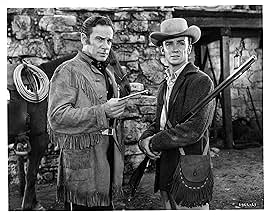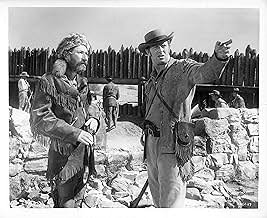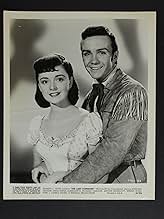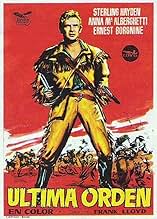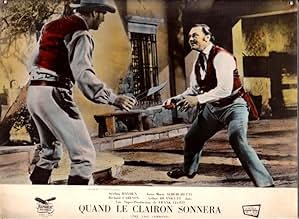IMDb-BEWERTUNG
6,2/10
1037
IHRE BEWERTUNG
Füge eine Handlung in deiner Sprache hinzuModerate Jim Bowie leads rebellious Texicans--and Davy Crockett--in a last-ditch stand against his old friend, Santa Ana.Moderate Jim Bowie leads rebellious Texicans--and Davy Crockett--in a last-ditch stand against his old friend, Santa Ana.Moderate Jim Bowie leads rebellious Texicans--and Davy Crockett--in a last-ditch stand against his old friend, Santa Ana.
- Regie
- Drehbuch
- Hauptbesetzung
Abdullah Abbas
- Townsman
- (Nicht genannt)
Rico Alaniz
- Tomas
- (Nicht genannt)
Empfohlene Bewertungen
Forget any adherence to historical facts, directed by Frank Lloyd and with a Warren Duff screenplay, The Last Command is a slow moving piece that uses Jim Bowie as its focal point. Starring Sterling Hayden (Bowie), Richard Carlson (William Travers), Arthur Hunnicutt (Davy Crockett), Ernest Borgnine (Mike Radin), J. Carrol Naish (Santa Ana), and Anna Maria Alberghetti (Consuela), the piece was a project long courted by John Wayne. However, Republic refused to sanction the type of budget the Duke wanted for his vision. So after offering him a nominal fee for a part, he refused and Republic promptly went on to make the film anyway. The final result is an interesting film that finally pays off for those having the patience and tolerance for patriotic flag waving.
The story follows the battle of the Alamo in San Antonio in 1836, where brave Texans gave their life to become free of the Mexican rule, by defending the former mission station against overwhelming odds as the Mexican army of Santa Ana closed in for victory. The final battle is very well staged by Lloyd, and the acting, though not making the earth move, is very competent, particularly Hayden who does a nice line in tortured ruggedness. Max Steiner provides a zippy score and the low budget use of Trucolor doesn't affect the work of cinematographer Jack Marta. Safe and enjoyable as a story telling piece, if ultimately far from being a rousing spectacle fit for that particular part in history. 6/10
The story follows the battle of the Alamo in San Antonio in 1836, where brave Texans gave their life to become free of the Mexican rule, by defending the former mission station against overwhelming odds as the Mexican army of Santa Ana closed in for victory. The final battle is very well staged by Lloyd, and the acting, though not making the earth move, is very competent, particularly Hayden who does a nice line in tortured ruggedness. Max Steiner provides a zippy score and the low budget use of Trucolor doesn't affect the work of cinematographer Jack Marta. Safe and enjoyable as a story telling piece, if ultimately far from being a rousing spectacle fit for that particular part in history. 6/10
Frank Lloyd's career stretched back to the silent era--he was a major director and made films for the top studios in Hollywood. Winding up at a B studio like Republic would seem to be a step down the career ladder, but this film is actually one of Lloyd's best and one of the best to ever come out of Republic.
The studio didn't often get the services of directors of the calibre of Frank Lloyd--although John Ford and Fritz Lang had occasionally made films there--and it spared no expense on this one. The subject matter demanded a big budget, and Republic didn't stint. Thousands of extras, big sets, spectacular action scenes, robust performances--all combined to make a first-rate action picture. Sterling Hayden makes a good Jim Bowie, the always underrated Arthur Hunnicutt personifies Davy Crockett, and the cast is filled with familiar character actors--Roy Roberts, Slim Pickens, John Russell, Jim Davis--who contribute much to the overall atmosphere of the film. The setpiece of the movie, though, is the final siege of the Alamo itself, and it is spectacular. It compares well to the John Wayne version made five years later, and ranks right up there with the final battle scene in 1964's "Zulu"--expertly edited with top-notch stunt-work and special effects. Very highly recommended.
The studio didn't often get the services of directors of the calibre of Frank Lloyd--although John Ford and Fritz Lang had occasionally made films there--and it spared no expense on this one. The subject matter demanded a big budget, and Republic didn't stint. Thousands of extras, big sets, spectacular action scenes, robust performances--all combined to make a first-rate action picture. Sterling Hayden makes a good Jim Bowie, the always underrated Arthur Hunnicutt personifies Davy Crockett, and the cast is filled with familiar character actors--Roy Roberts, Slim Pickens, John Russell, Jim Davis--who contribute much to the overall atmosphere of the film. The setpiece of the movie, though, is the final siege of the Alamo itself, and it is spectacular. It compares well to the John Wayne version made five years later, and ranks right up there with the final battle scene in 1964's "Zulu"--expertly edited with top-notch stunt-work and special effects. Very highly recommended.
Studio politics prevented John Wayne from getting the role he coveted.Wayne would have to wait nearly a decade before he would put his own vision of the Alamo on the silver screen. The film is magnificent and told remarkable for its era (a) with a recognition that Mr Bowie having married into the Mexican elite had become an assimilato, a naturalized Mexicano, (b) with sympathy for the Mexican viewpoint and (c) with respect for General Santa Ana.
The Travis of this version is not nearly the superbly arrogant martinet of the Wayne film nor the dummy who matures in combat of the more recent edition.
Regrettably unlike the Wayne film, this version omits the heroine of the story who knitted the Alamo flag-- the Mexican tricolor with the legend 1824 for the liberal constitution for which the Texans fought. Cut off by the Mexicans, the Alamo defenders would never have known of the declaration of independence or the adoption of the Lone Star flag.
Yet as the story of heroism against the odds, Last Command is first rate.
The Travis of this version is not nearly the superbly arrogant martinet of the Wayne film nor the dummy who matures in combat of the more recent edition.
Regrettably unlike the Wayne film, this version omits the heroine of the story who knitted the Alamo flag-- the Mexican tricolor with the legend 1824 for the liberal constitution for which the Texans fought. Cut off by the Mexicans, the Alamo defenders would never have known of the declaration of independence or the adoption of the Lone Star flag.
Yet as the story of heroism against the odds, Last Command is first rate.
Made in spite by Yates, well shot and mounted, replete with an excellent cast, 'The Last Command' still remains good value even if it rather pales besides Wayne's grandiose epic of just a few years later. The much underrated Hayden is superb as "big Jim Bowie" and Hunnicutt equally as good as Davy Crockett. Hayden has the ability to appear gentle, naive, rugged and brusque all at once - something few other actors, with perhaps the exception of Spencer Tracy, managed. Unfortunately Crockett and his 29 men don't appear until some way in. With only Hayden's latent dynamism really keeping things afloat, the first half an hour of the film is rather talkative in exposition, and it drags somewhat. Consuela de Quesada (Anna Marie Alberghetti) is a limp romantic foil to Bowie - I for one would be happy to have seen her written out and the structure tightened through her absence. Ernest Borgnine plays his small role with gusto - his confrontation with Bowie a standout scene in a film full of fighting, although his later genial acceptance of Bowie's superiority as a man is perhaps emphasised by the script too much for comfort.
Steiner's music (and especially the superb title song) goes a long way in making events move smoothly towards the climax. For it's the Alamo Battle the bums on seats will have come to see, and here it is done well (although again not *as* well as Wayne would manage with considerable more time and resources later (although any comparison isn't too much to the present film's detriment).
In short this is well worth seeing, and it provides a contemporarily staged contrast to the better-known epic which was to follow. I'd still like to see an historically accurate account of the events at the mission, though...
Steiner's music (and especially the superb title song) goes a long way in making events move smoothly towards the climax. For it's the Alamo Battle the bums on seats will have come to see, and here it is done well (although again not *as* well as Wayne would manage with considerable more time and resources later (although any comparison isn't too much to the present film's detriment).
In short this is well worth seeing, and it provides a contemporarily staged contrast to the better-known epic which was to follow. I'd still like to see an historically accurate account of the events at the mission, though...
In the habitual group of various characters we find the starring Jim Bowie of ¨Bowie knife¨ fame (Sterling Hayden) who held command until stricken with typhoid-pneumonia , Colonel William Barret Travis (Richard Carlson) , commander of the small garrison of some 180 men and Davy Crockett of Tenesse (Arthut Hunnicutt) who had arrived with a dozen volunteers . They're guarding El Alamo against a Mexican militia commanded by General Antonio Lopez De Santa Anna , President of Mexico (J. Carroll Nash) . They're featured in more realistic roles than successive films , though here predominates the melodrama . It's a spectacular film hampered by a tiring screenplay and including Max Steiner's excellent score with a title song by Gordon McRae . The motion picture well produced by Republic's founder , Herbert J. Yates, was professionally directed by Frank Lloyd . Subsequently , five years later , John Wayne made his own retelling : ¨El Álamo¨ (1960) , utilizing a lot of the still-standing sets that were used in this movie .
The film is rightly based on historic events , these are the followings : On 23 February 1836 a army of 5000 entered San Antonio. When Santa Anna demanded the surrender, William Travis answered with a cannon shot. So began thirteen day siege that ended with the Mexicans storming the fortress, the defenders, to a man , fought on until death .With bugles sounding the ¨deguello¨(signifying no quarter to the defenders) attacked the adobe walls from all four sides and broke through. Travis was shot dead over his cannon . Crockett using his rifle as a club, fell under a swarm of the enemy . Bowie fought to the last from his sickbead. The Mexicans had won a Pyrrhic victory suffering more than 1500 casualties. Forty six days after the fall ,less than 800 Texans and American volunteers led by General San Houston defeated Santa Anna and his army of 1300 at San Jacinto. Shouting ¨Remember the Alamo¨ Houston's men completely routed the Mexicans in a matter of minutes, killing 630 while losing only 8. Santa Anna was captured, and the Republic of Texas was born.
The film is rightly based on historic events , these are the followings : On 23 February 1836 a army of 5000 entered San Antonio. When Santa Anna demanded the surrender, William Travis answered with a cannon shot. So began thirteen day siege that ended with the Mexicans storming the fortress, the defenders, to a man , fought on until death .With bugles sounding the ¨deguello¨(signifying no quarter to the defenders) attacked the adobe walls from all four sides and broke through. Travis was shot dead over his cannon . Crockett using his rifle as a club, fell under a swarm of the enemy . Bowie fought to the last from his sickbead. The Mexicans had won a Pyrrhic victory suffering more than 1500 casualties. Forty six days after the fall ,less than 800 Texans and American volunteers led by General San Houston defeated Santa Anna and his army of 1300 at San Jacinto. Shouting ¨Remember the Alamo¨ Houston's men completely routed the Mexicans in a matter of minutes, killing 630 while losing only 8. Santa Anna was captured, and the Republic of Texas was born.
Wusstest du schon
- WissenswertesThe melody to "The Ballad of Rock Ridge" from the western spoof Der wilde wilde Westen (1974) is taken almost note for note from this film's "Jim Bowie", sung by Gordon MacRae. Coincidentally, Slim Pickens appears in both films.
- PatzerWhen Gen. Santa Ana's cavalry charges toward the Alamo, the tire tracks of the camera truck are visible in front of the horses.
- VerbindungenFeatured in That's Action (1977)
- SoundtracksJim Bowie
by Sidney Clare and Max Steiner
Sung by Gordon MacRae
A Capitol Recording Artist
Arranged by Van Alexander (uncredited)
Top-Auswahl
Melde dich zum Bewerten an und greife auf die Watchlist für personalisierte Empfehlungen zu.
- How long is The Last Command?Powered by Alexa
Details
Box Office
- Budget
- 2.193.939 $ (geschätzt)
- Laufzeit1 Stunde 45 Minuten
- Seitenverhältnis
- 1.66 : 1
Zu dieser Seite beitragen
Bearbeitung vorschlagen oder fehlenden Inhalt hinzufügen

Oberste Lücke
By what name was Die Barrikaden von San Antone (1955) officially released in India in English?
Antwort
